Imagine walking barefoot in a garden filled with wildflowers. The sun shines, and bees buzz around. It’s more than a garden; it’s a place where nature and creativity meet.
Do you dream of a garden that’s full of life and fun? Hippie-chic gardens are about celebrating life and caring for the earth. They turn your yard into a storybook of wonder.
Think of your backyard as a canvas. You can make it a magical place where every detail invites you to relax. Hippie-garden-ideas are all about embracing the beauty of imperfection and creating a space that reflects you.
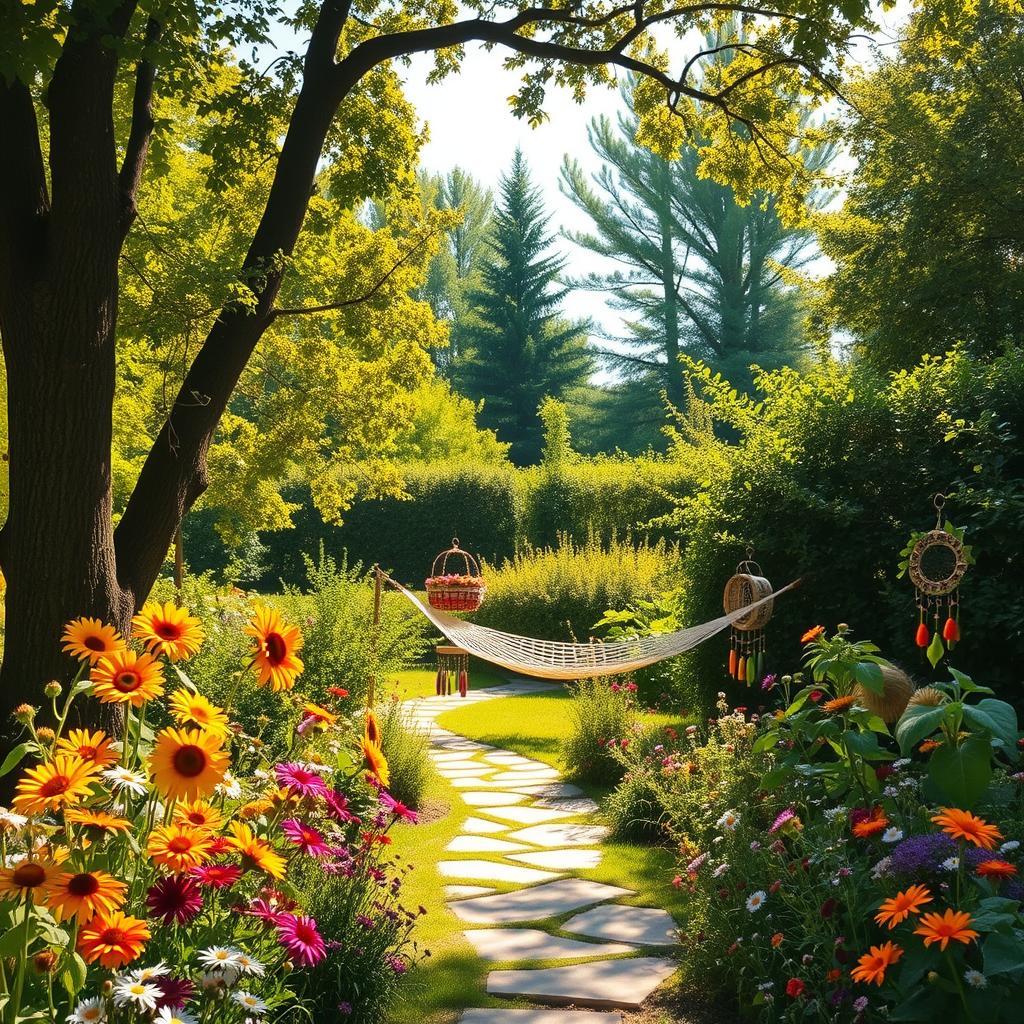
These gardens are a love letter to our planet. They’re built on care, with native flowers for butterflies and recycled materials. It’s about finding balance and connecting with nature.
Key Takeaways
- Hippie-chic gardens blend sustainability with artistic expression.
- Create a whimsical outdoor space that reflects your personal style.
- Focus on plants and materials that support local ecosystems.
- Turn everyday items into garden art to reduce waste.
- Design a sanctuary that invites reflection and connection with nature.
Embracing the Hippie Garden Philosophy
Every hippie-garden-idea has a story of rebellion and renewal. It started in the 1960s, mixing counterculture with Eastern philosophies. By understanding its roots, you can create a space that’s both personal and meaningful.
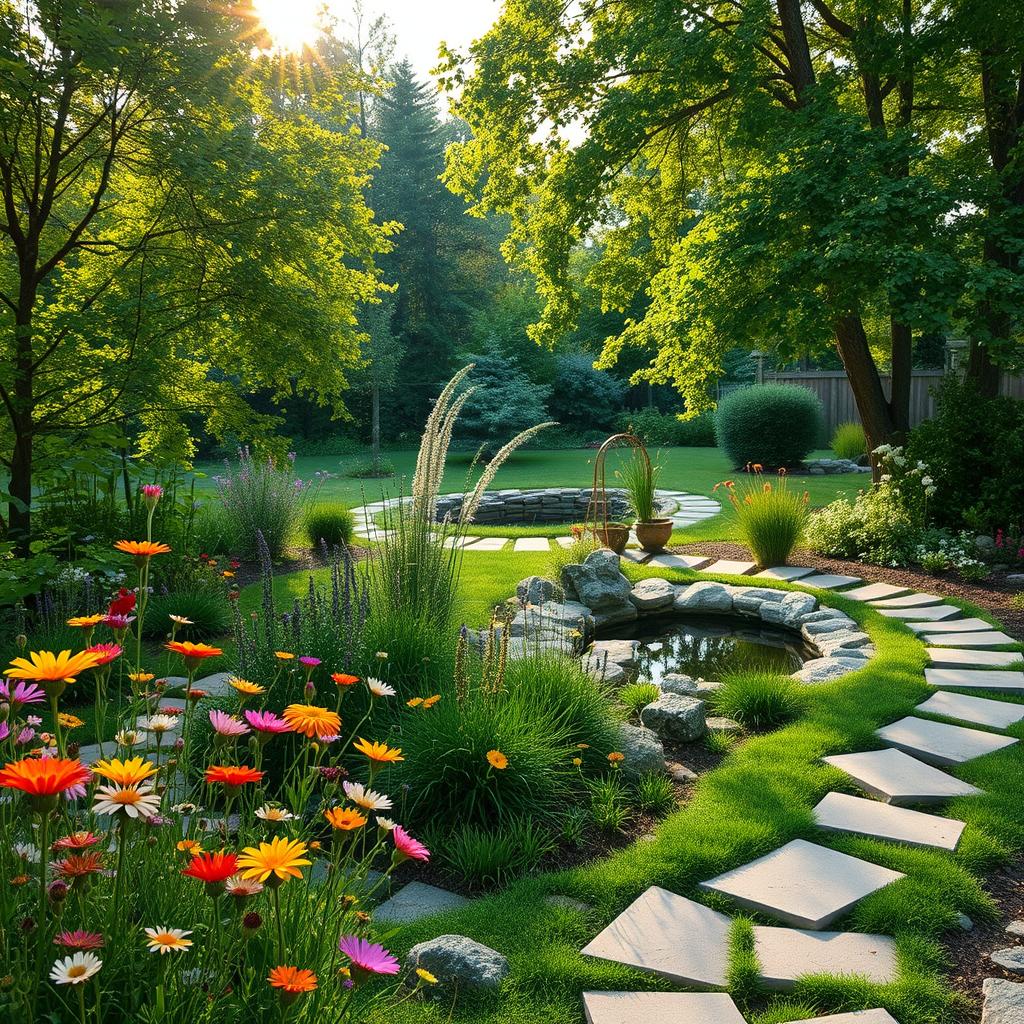
The Origins of Hippie Garden Aesthetics
These gardens began in the 1960s, when activists and artists challenged societal norms. They drew inspiration from folk art, Zen gardens, and Native American land care. It’s about embracing authenticity over perfection.
Core Principles: Peace, Love, and Sustainable Growth
- Harmony with nature: Use native plants and organic materials.
- Creative freedom: Let plants grow wild, mixing colors and textures.
- Community focus: Create spaces for gatherings or quiet reflection.
- Ethical choices: Choose recycled materials and eco-friendly methods.
How Hippie Gardens Differ from Traditional Landscaping
Traditional gardens often seek symmetry and manicured lawns. Hippie-inspired spaces are different:
- They have organic layouts with winding paths and mixed plantings.
- They use unpretentious materials like salvaged wood or river rocks.
- They celebrate imperfect beauty—cracked pottery, mismatched containers, and wildflower meadows.
By following these principles, you can turn your yard into a peaceful retreat. It honors heritage and modern sustainability goals.
Essential Plants for Your Hippie-Garden-Ideas
Choosing the right plants can turn any space into a thriving hippie oasis. These selections blend beauty, purpose, and eco-conscious choices. They align with sustainable gardening tips.
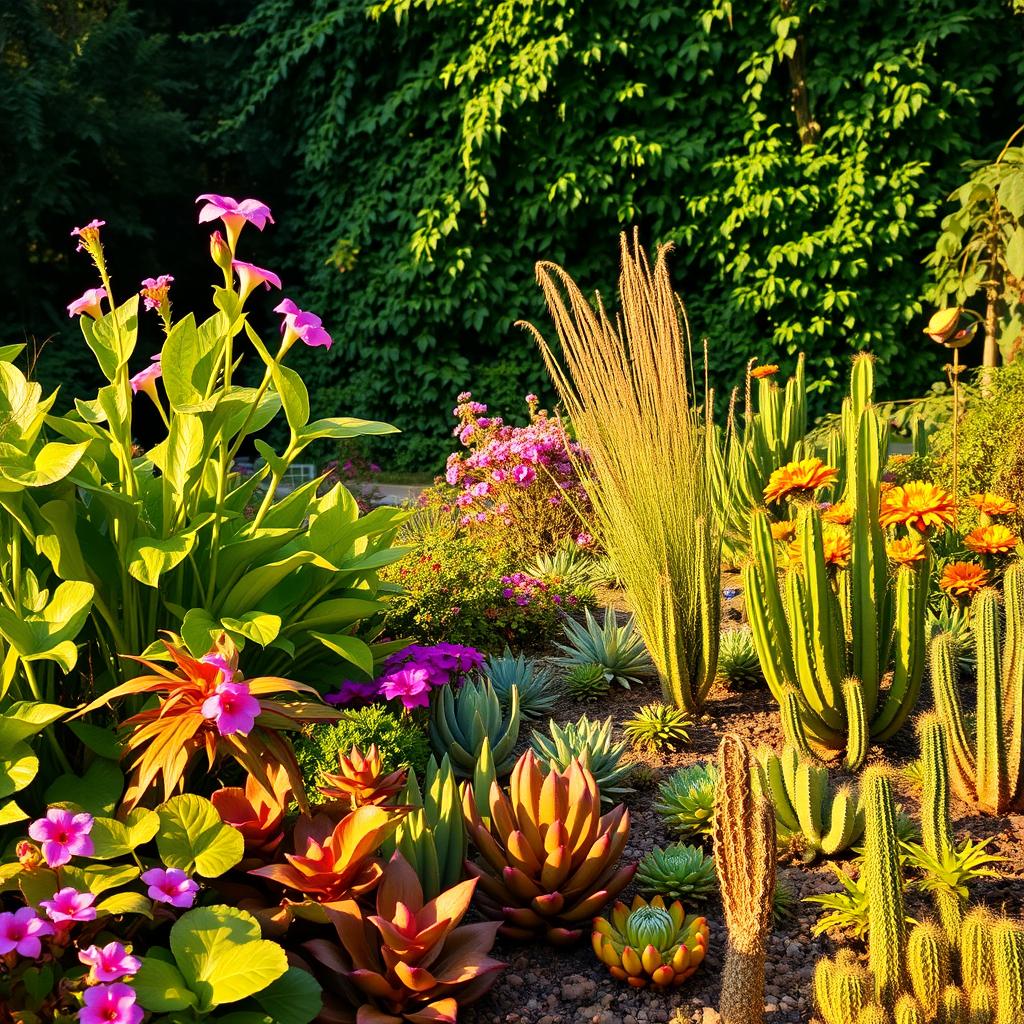
Vibrant Flowering Plants That Attract Pollinators
Bring color and life with these pollinator-friendly blooms:
- Sunflowers: Towering sunflowers add bold vertical interest while feeding bees
- Zinnias: Easy-to grow annuals in rainbow hues
- Cosmos: Delicate blooms that thrive in poor soil
Medicinal Herbs for Wellness and Beauty
Grow these multipurpose plants for teas, remedies, and natural beauty routines:
- Echinacea: Immune-boosting roots and cheerful purple blooms
- Lavender: Calming scent plus pest-repelling properties
- Chamomile: Gentle flowers for teas and skin tonics
Low-Maintenance Native Species
| Plant Type | Examples | Benefits |
|---|---|---|
| Flowering | Black-eyed Susan, Coneflower | Support local pollinators |
| Herbs | Mint, Yarrow | Require little water/no pesticides |
| Groundcovers | Wild Strawberry, Creeping Thyme | Prevent soil erosion naturally |
Pair native plants with organic mulch and rainwater systems for true sustainable gardening tips. Mix varieties to create layered, evolving landscapes. These celebrate nature’s imperfections.
Creating a Free-Spirited Garden Layout
Start designing your whimsical outdoor space by mixing creativity with practicality. Map out winding paths that follow your land’s natural shape. This approach saves effort and boosts eco-friendly garden design.
Let plants grow freely, without strict rows. Use stepping stones or mulch to guide visitors. This way, you don’t limit plant growth.
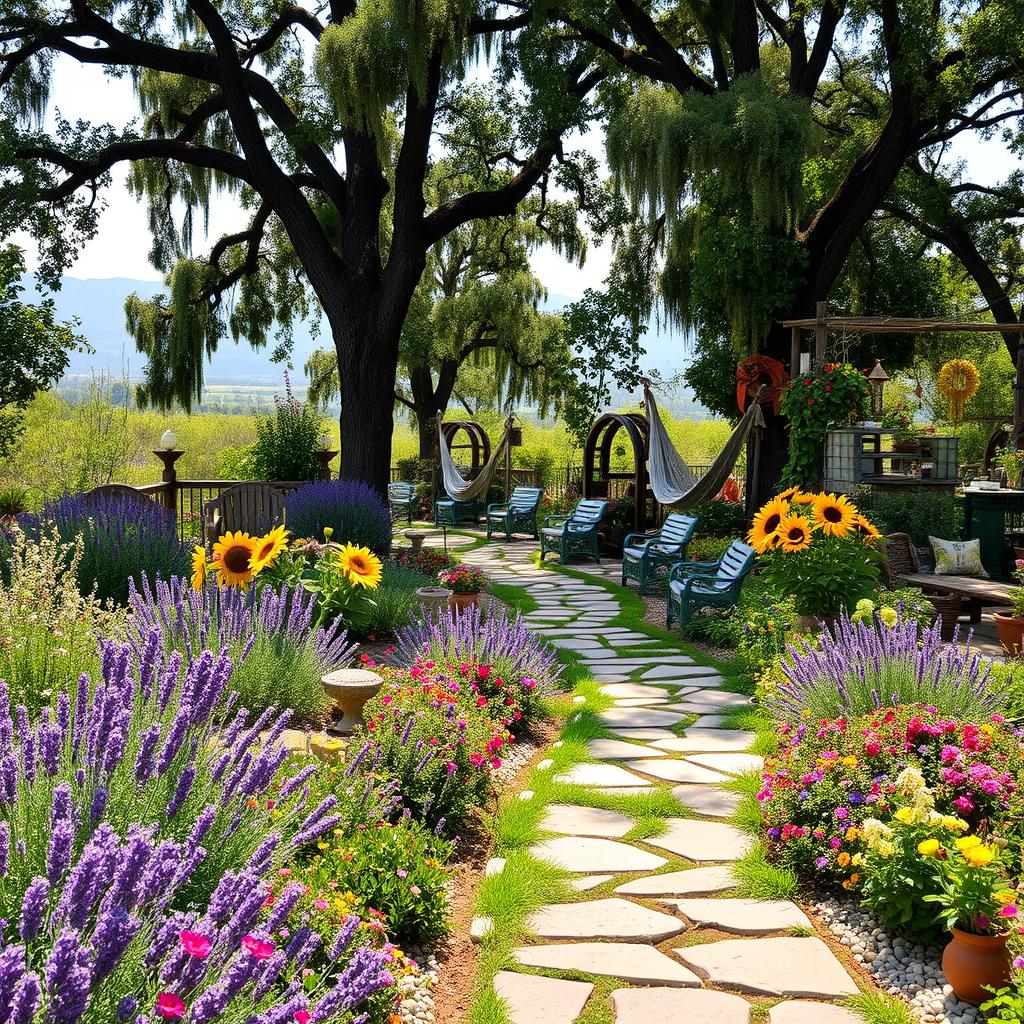
- Create “rooms” with tall grasses or shrubs for distinct seating or meditation areas.
- Add unexpected elements like a salvaged fountain or a mosaic bird bath for visual surprises.
- Position benches or hammocks where paths intersect for natural resting spots.
Group plants by their needs to save resources. Here’s how:
| Plant Type | Water Needs | Sun Exposure |
|---|---|---|
| Lavender | Low | Full sun |
| Ferns | Moderate | Partial shade |
| Sunflowers | High | Full sun |
Use stones or logs as informal borders between plant clusters. Let vines climb fences naturally instead of pruning them into shapes. This cuts down on maintenance and boosts biodiversity.
Trust your instincts—your whimsical outdoor space should reflect your personality. Every curve and corner tells a story when you design with intention and playfulness.
Upcycled Container Gardens: From Trash to Treasure
Turn old items into beautiful garden pieces. Make trash into art that shows your style and helps the planet.
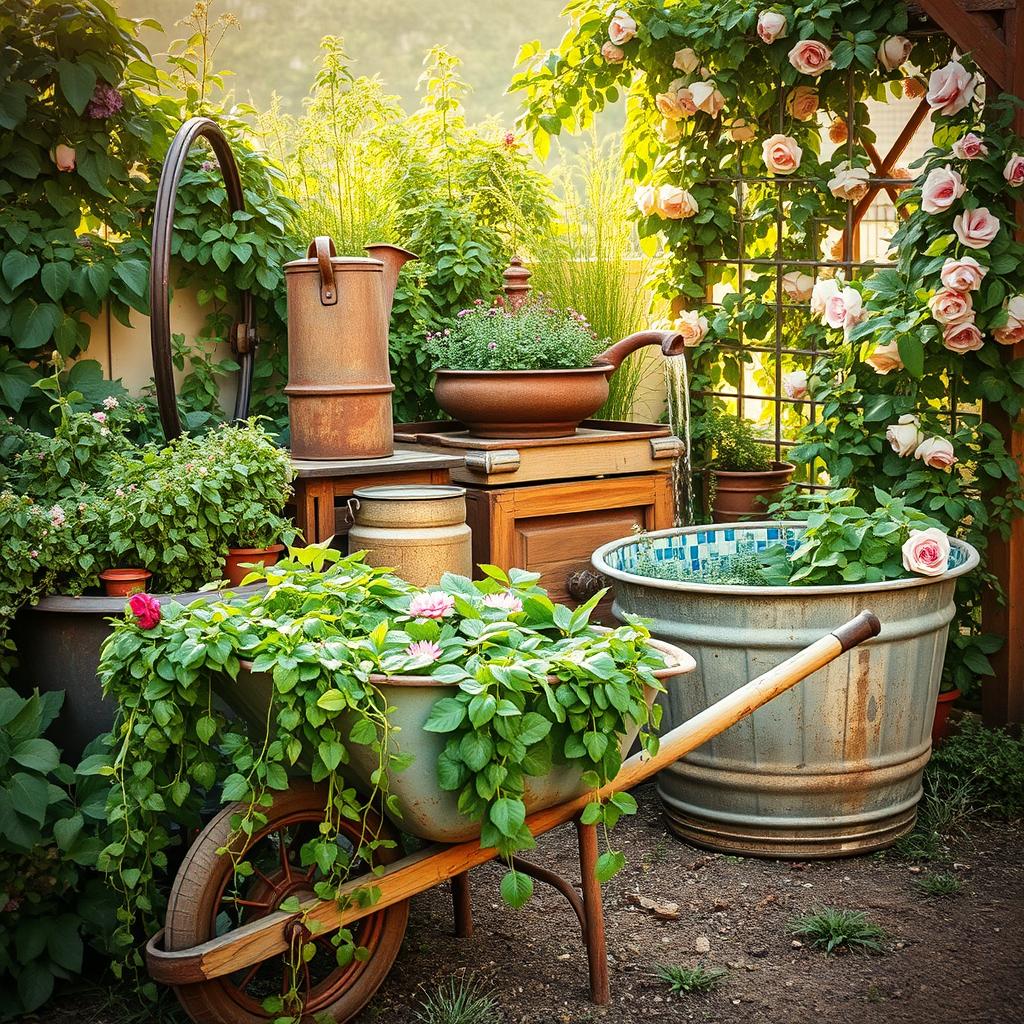
Repurpose Vintage Finds as Planters
Old dressers, suitcases, or toolboxes can be amazing garden features. First, drill holes for drainage to keep plants healthy. Then, fill with good soil and pick plants that spill over, like ivy or succulents.
Thrift stores and flea markets are great for finding vintage garden inspiration. Think about using old suitcases for herbs or turning a ladder into a vertical herb rack.
Build Vertical Gardens with Reclaimed Wood
- Use pallets or fence slats to create wall-mounted planters.
- Attach gutters to fences for cascading flowers or veggies.
- Paint or stain materials for weather protection and style.
These sustainable gardening tips help use small spaces well. Add herbs or strawberries to a gutter setup—easy to pick!
Create Mosaic Pots from Broken Ceramics
Make stunning mosaics from broken dishes. Here’s how:
- Clean and dry broken pottery shards.
- Apply waterproof adhesive to a clay pot base.
- Arrange pieces in patterns, let dry completely.
Seal with clear outdoor sealant to protect your art. These pots add fun and keep waste out of landfills.
“Every upcycled piece tells a story—let your garden speak volumes.”
Whether it’s furniture or mosaics, these projects are good for the earth and show your creativity. Start small, try new things, and watch your garden grow with meaning.
Bohemian Outdoor Decor That Defines Your Space
Make your garden a lively showcase of freedom with bohemian outdoor decor. Each item should share a story, mixing textures, colors, and cultures. This approach reflects your love for nature and creativity. It also celebrates sustainability and artistry, just like hippie-garden-ideas.
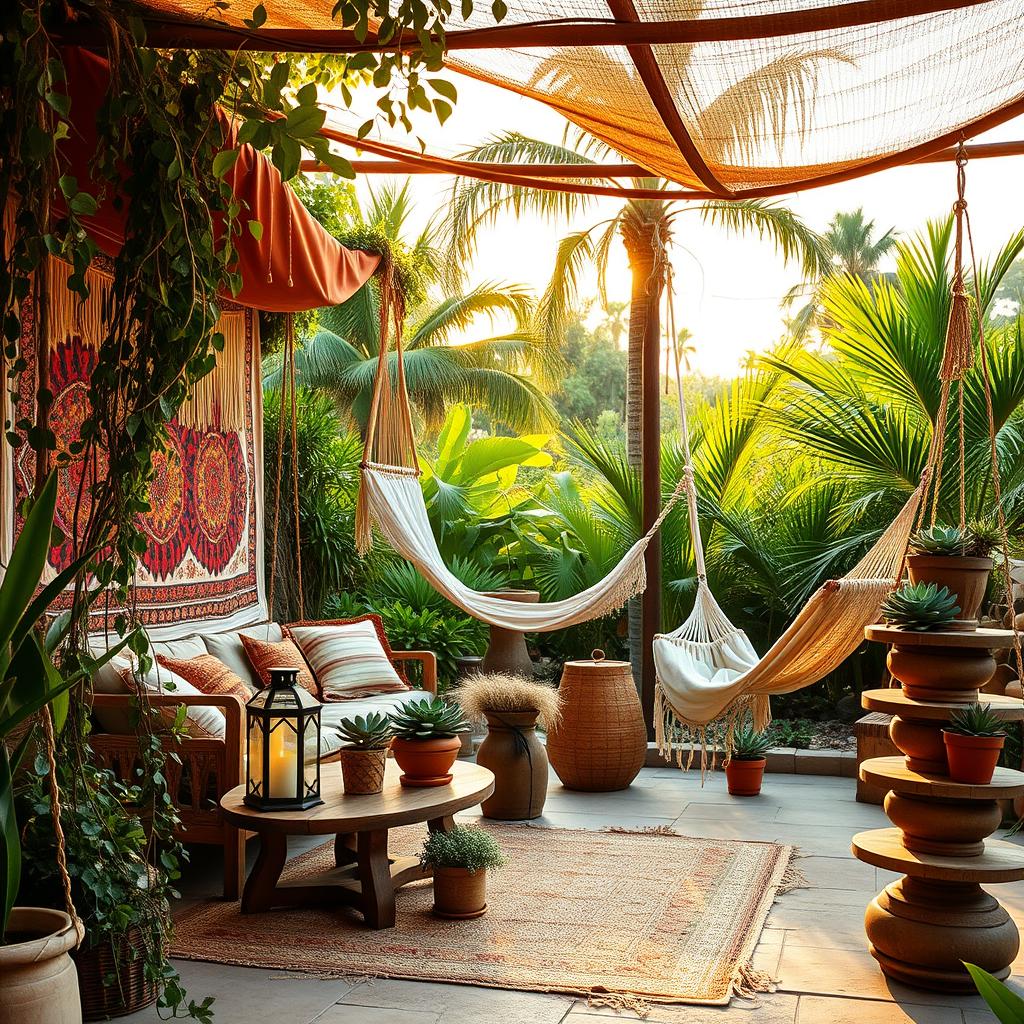
Handcrafted Wind Chimes and Mobiles
Use recycled materials to create wind chimes. Try driftwood, seashells, or metal scraps. For mobiles, balance feathers, dried flowers, or ceramic discs on wire. These pieces bring sound and sight, turning quiet spots into lively areas.
Colorful Textiles for Outdoor Seating Areas
- Wrap rattan furniture with patterned cushions made from outdoor fabrics like Sunbrella or linen blends.
- Hang Indonesian batik throws or Moroccan-inspired embroidered cushions for a global touch.
- Place woven jute rugs under seating to add earthy textures.
Prayer Flags and Banner Making Techniques
Decorate your garden with hand-painted banners or traditional prayer flags. Use natural dyes on cotton or hemp to write personal mantras or symbols inspired by nature. Hang them between trees to create living art that changes with the weather and seasons.
“Every flag you hang becomes a silent guardian of your garden’s spirit.”
Natural Dye Gardens: Growing Plants for Color
Make your garden a dye factory with natural plant dye techniques. Plants like indigo and marigolds add beauty and function. They bring back vintage garden inspiration from old homesteads. These plants turn your garden into a colorful canvas and a useful resource.
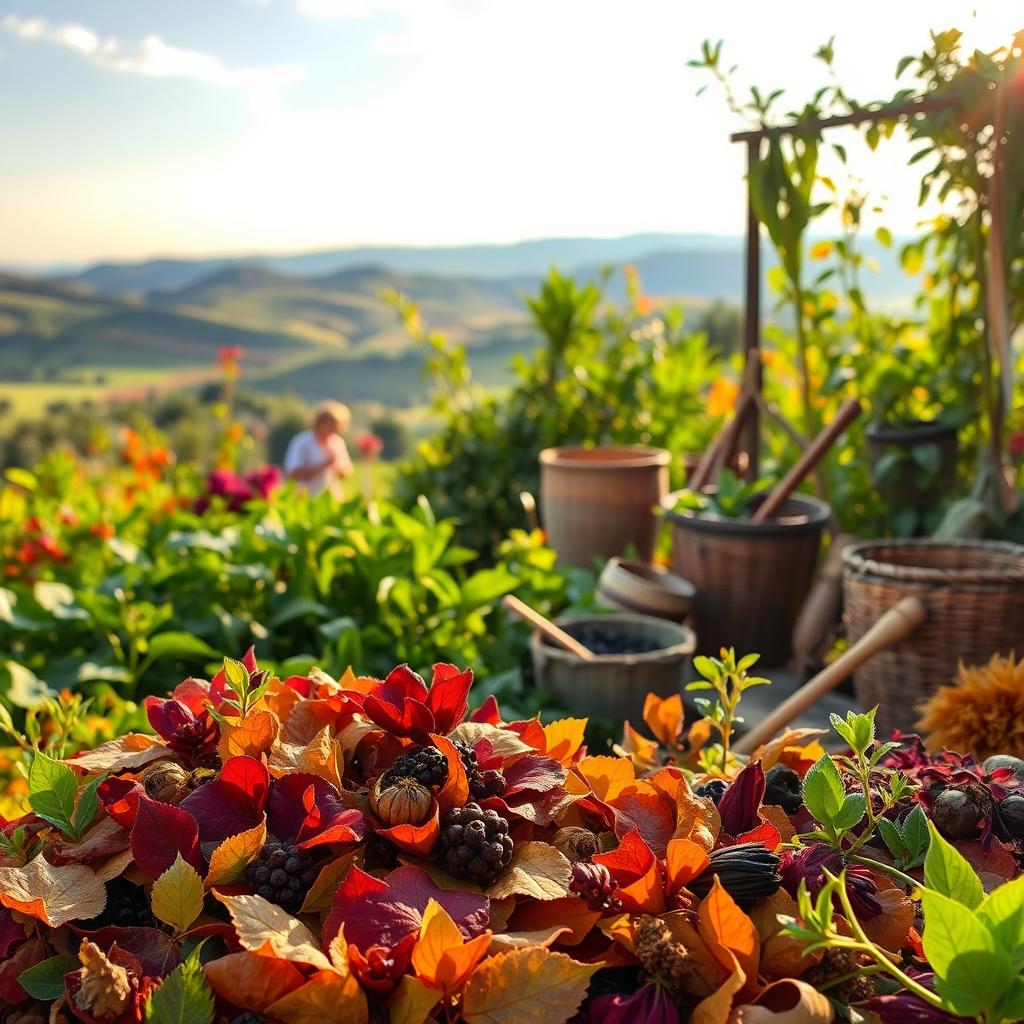
| Plant | Color | Best For |
|---|---|---|
| Indigo | Deep blues | Clothing and textiles |
| Madder Root | Rich reds | Hand-dyed fabrics |
| Weld | Sunshine yellows | Home textiles |
| Marigolds | Golden oranges | Paper and crafts |
| Berries | Purples/pinks | Cosmetics and art |
Plant dye crops love full sun and your garden. Mix dye plants with flowers and veggies for a diverse garden. Pick foliage, roots, or petals when colors are brightest, usually just before they bloom.
- Indigo needs moist soil and regular water
- Madder likes well-drained soil in full sun
- Weld grows best in dry, rocky soil
Start small to learn natural plant dye techniques. Boil plant parts in water to get the colors. Then, use mordants like vinegar or alum to dye fibers. Test small amounts first to see how colors change with seasons and soil.
Keep a dye journal to track your progress. Many old homesteaders documented their dye results. Your garden becomes a place to create art sustainably, using nature’s colors instead of chemicals.
Designing a Meditation Space in Your Hippie Garden
Turn a corner of your garden into a peaceful backyard retreat. Here, mindfulness meets nature. It’s a whimsical outdoor space that encourages calm.
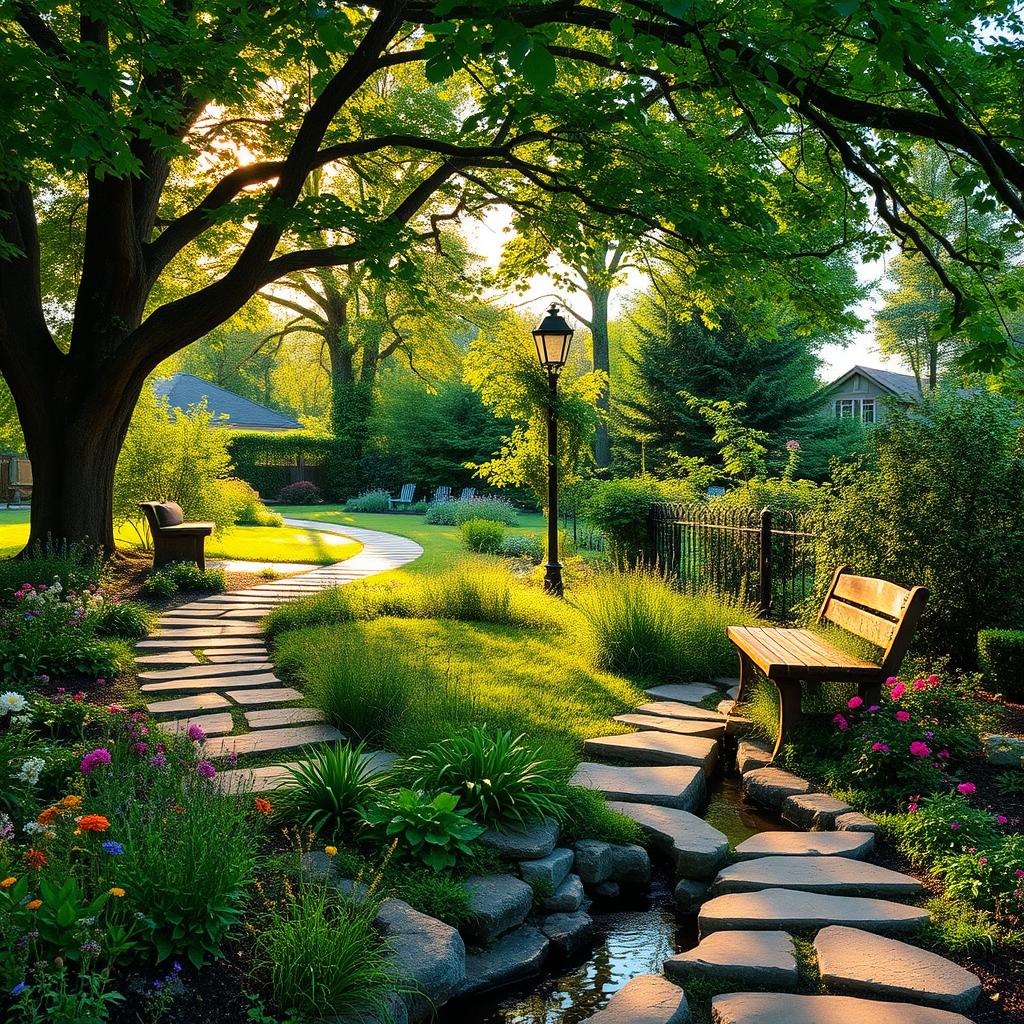
Stone Arrangements and Labyrinths
Use stones to create mindful patterns. Try these ideas:
- Zen-inspired rock clusters near seating areas
- Walking labyrinths using river rocks or cobblestones
- Fire pit circles for evening reflections
Add a small water feature like a tabletop fountain to enhance tranquility.
Creating a Sensory Experience with Fragrant Plants
| Plant | Scent | Mindfulness Benefits |
|---|---|---|
| Lavender | Calming floral | Reduces stress |
| Jasmine | Sweet, uplifting | Enhances focus |
| Rosemary | Pungent herbal | Sharpens concentration |
Place these plants near seating for an aromatic journey. It engages your senses without overwhelming the space.
Weather-Resistant Cushions and Seating Options
Choose weatherproof materials for comfort:
- Cushions stuffed with quick-dry foam and UV-treated fabric
- Reclaimed wood benches with rounded edges
- DIY mosaic-topped concrete planters as impromptu seats
Layer organic materials like sheepskin rugs or jute mats. They add texture and withstand outdoor conditions.
Sustainable Gardening Practices for Earth-Conscious Gardeners
Every eco-friendly garden design thrives on practices that nurture the planet. These sustainable gardening tips turn everyday actions into earth-positive habits. Start small, and watch your garden grow in harmony with nature.
Composting Basics for Beginners
Turn kitchen scraps into nutrient-rich soil with composting. Layer greens (fruit peels, grass clippings) and browns (leaves, cardboard) in a bin or open pile. Avoid meat/dairy to prevent odors. Turn the pile weekly to speed up decomposition. Use finished compost to enrich garden beds—nature’s perfect fertilizer.
- Do: Add coffee grounds and eggshells for pH balance.
- Don’t: Include weeds with seeds or chemically treated materials.
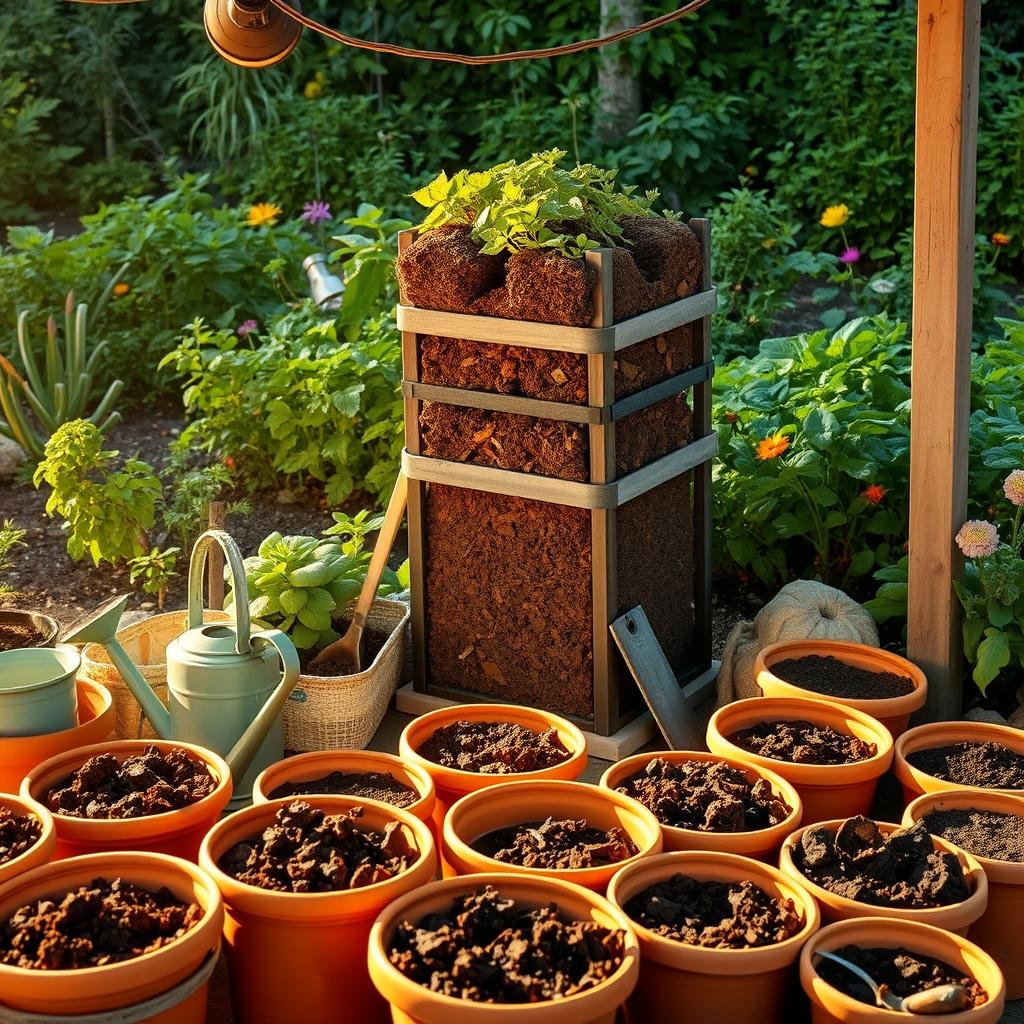
Rainwater Collection Systems on a Budget
Catch rainwater to reduce waste and save money. Position barrels under downspouts, or dig shallow ditches (swales) to direct runoff into planting zones. Use a screen on barrels to block debris. Check local regulations—some regions require permits for large systems. Reuse materials like old drums or recycled plastic containers to stay budget-friendly.
Companion Planting for Natural Pest Control
Pair plants strategically to deter pests and boost growth. Basil near tomatoes repels aphids; marigolds ward off nematodes. Planting flowers like nasturtiums between veggies creates a living mulch that crowds out weeds. This method cuts pesticide use while boosting biodiversity—perfect for an eco-friendly garden design.
“Nature’s teamwork: plants protect each other better than chemicals ever could.”
- Tomatoes + basil = aphid-free feast.
- Cucumbers + sunflowers = natural trellises.
Hosting Garden Gatherings: Community Spaces in Bohemian Style
Make your garden a place for connection with bohemian decor. It’s not about being alone—it’s about welcoming friends and neighbors. Use mismatched chairs, colorful cushions, and handwoven rugs for flexible seating.
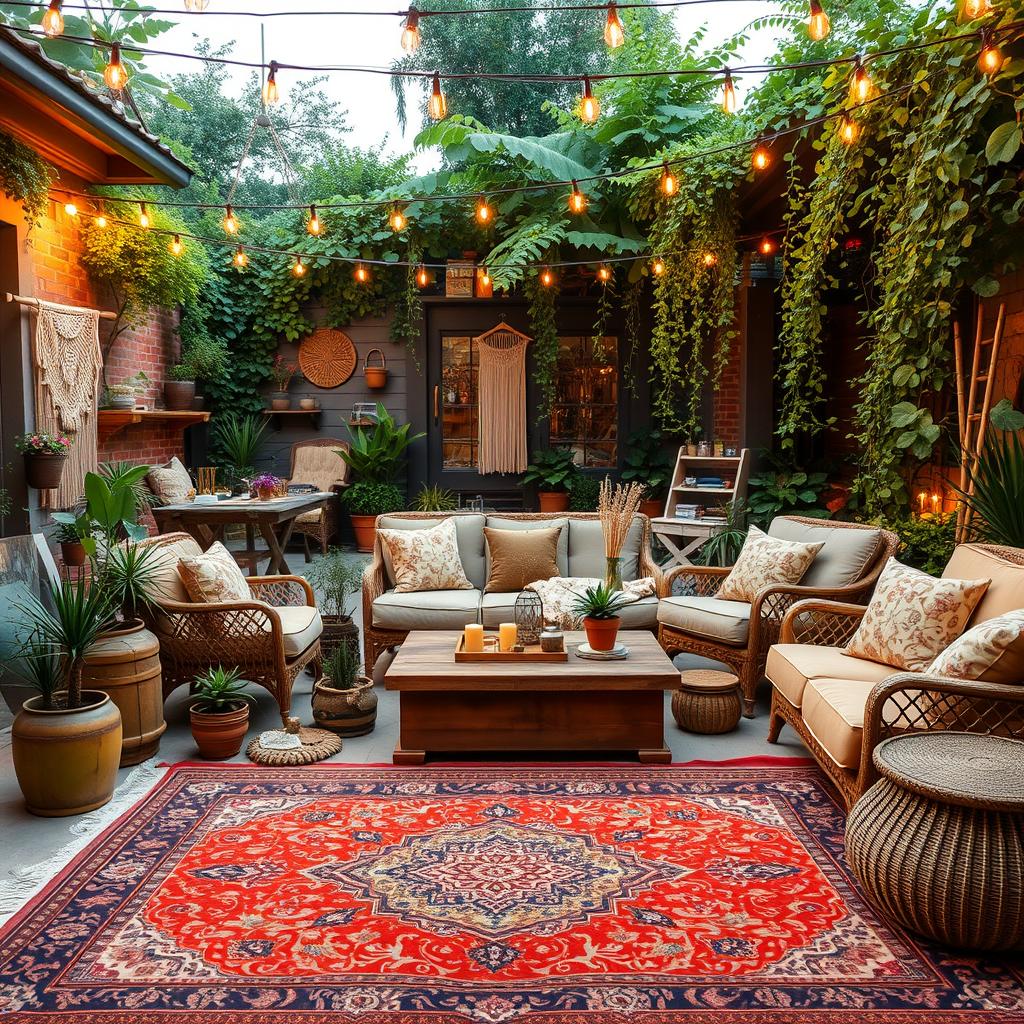
- Hang string lights or paper lanterns to cast a warm glow.
- Arrange low tables for shared meals using mismatched dishes and embroidered cloths.
- Add a fire pit surrounded by stones or potted herbs for cozy gatherings.
| Element | Idea |
|---|---|
| Shade | Canopy draped with fairy lights or vine-covered pergola |
| Activities | Workshops for making natural dyes or herb bundles |
| Seating | Circle of poufs or cushions under a tree |
Keep your space balanced by zoning areas. Have a meditation corner and a main gathering spot. Use prayer flags or wind chimes as dividers. Your garden can be a place for both quiet moments and lively gatherings.
Seasonal Rituals and Celebrations for Your Whimsical Garden
Make your garden a place where you connect with nature’s cycles. Simple, fun rituals can celebrate growth, abundance, and the beauty of change.
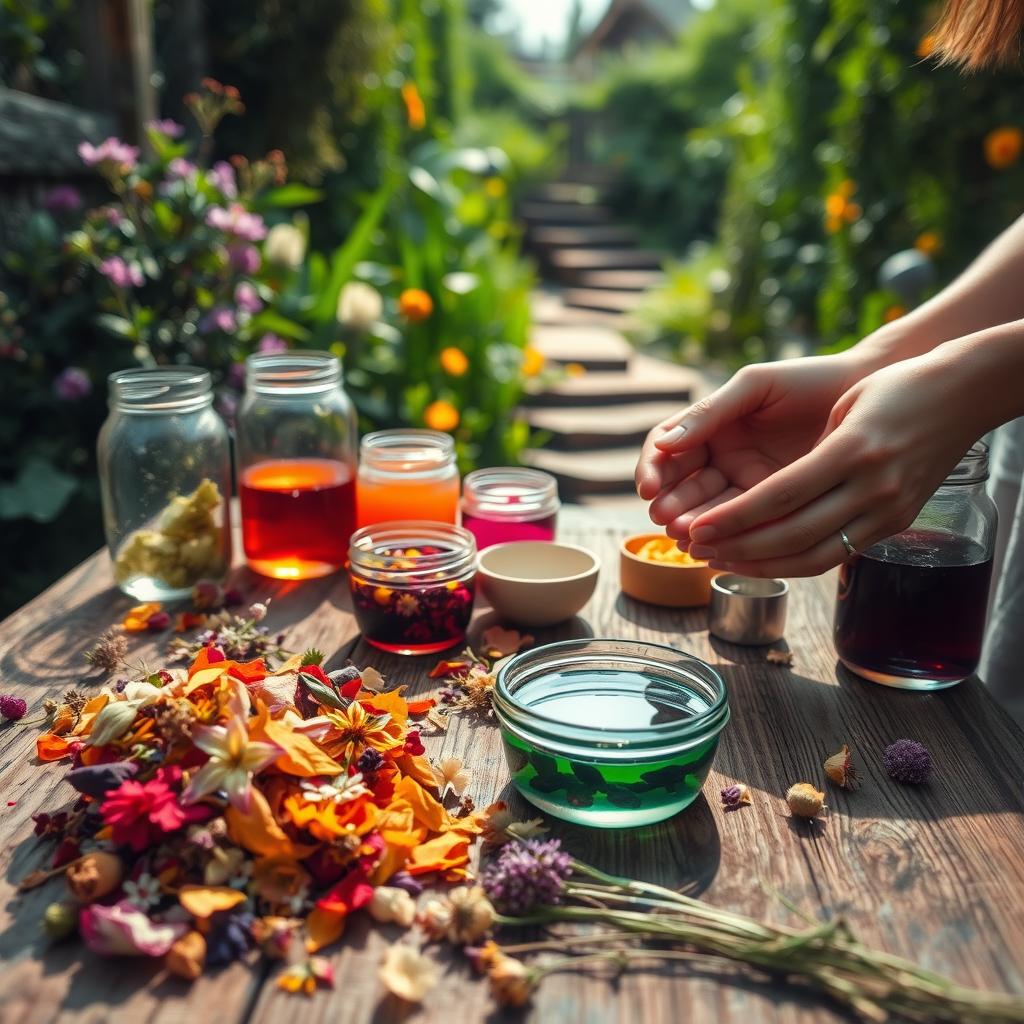
Solstice and Equinox Garden Activities
Start the longest day with a diy flower crown tutorial. Invite friends to:
- Collect flowers like lavender, sunflowers, or Queen Anne’s lace.
- Make a flexible circlet with vines or willow, adding greenery for support.
- Secure flowers with floral wire, making sure it fits well.
Have sunrise meditations at equinoxes or plant bulbs in winter solstice for a spring surprise.
Harvest Festivals and Sharing Your Garden’s Bounty
- Host potlucks where everyone brings dishes with garden herbs or veggies.
- Teach neighbors to make herb-infused oils or jams with extra produce.
- Give out seed gift bags to the community, with growing tips written by hand.
Creating Memory Rituals with Pressed Flowers and Herbs
Keep summer’s colors alive by pressing flowers between wax paper in heavy books. Use these dried flowers to:
Try natural plant dye techniques—use indigo leaves or blackberries to dye fabric scraps. Store pressed petals in journals or glue them onto handmade cards for friends. These small acts turn fleeting beauty into lasting art.
Conclusion: Let Your Garden Grow Wild and Free
Your hippie-garden-ideas start with a simple truth: nature blooms best when it’s free. Whether you’re setting up wildflower patches or using bohemian decor, every choice brings you closer to the earth. Think of your garden as a living canvas, where herbs and cosmos flowers grow together.
Wind chimes made from recycled materials add a musical touch to the air. Remember, when others doubt you, just wait for the beauty to show itself. Letting go of perfection is not a weakness; it’s the essence of this approach.
A sun-bleached ladder turned into a planter or mismatched mosaic pots show your creativity. Each imperfection has a story, encouraging you to enjoy the journey. Start small by hanging a prayer flag, planting marigold seeds, or turning an old door into a vertical garden.
Over time, these small acts create a sanctuary that reflects your values. Your garden is more than plants; it’s a promise to nurture joy, sustainability, and connection. So, get your hands dirty, hang those colorful textiles, and watch your vision grow. The world needs more places where earth and art come together, and yours can be one of them.
FAQ
What are some easy hippie-garden-ideas for beginners?
Start with colorful flowers like sunflowers and zinnias to attract pollinators. Create a small herb garden with plants like lavender and chamomile. Use vintage containers as planters to add a personal touch.
How can I implement sustainable gardening tips in my hippie garden?
Use native plants to support local ecosystems and save water. Compost to enrich your soil naturally. Install rainwater collection systems to conserve resources. Try companion planting to keep pests away and promote growth.
What are some ideas for bohemian outdoor decor in my garden?
Use handcrafted items like wind chimes and mobiles from natural materials. Add colorful textiles for seating and prayer flags for vibrancy. Incorporate vintage furniture or sculptures for a whimsical feel.
How do I create a peaceful backyard retreat?
Make a quiet area with comfy seating, fragrant plants, and soothing elements like water features. Surround yourself with nature. Add a small fire pit for warmth and ambiance during gatherings.
What is the process for making natural dyes using garden plants?
Grow plants like indigo, madder, or marigolds for vibrant colors. Harvest the plants and prepare your fibers. Create dye baths using water and mordants to fix the colors. Experiment with different plants and document your process.
How can I host garden gatherings in a whimsical outdoor space?
Design flexible seating for small talks and big celebrations. Use vintage dishware for charm. Add fun activities like plant exchanges or creative workshops to bond with your community.
Can you share a DIY flower crown tutorial for seasonal celebrations?
Yes! Choose sturdy stems from your garden. Create a base with floral wire and arrange flowers. Secure with floral tape and adjust for balance. This adds a festive touch to any celebration.
What are some natural plant dye techniques I can use with my garden flowers?
Boil plant materials to extract color or soak fibers in dye baths. Use vinegar or baking soda to change hues. Keep track of your results and mix plants for unique colors!